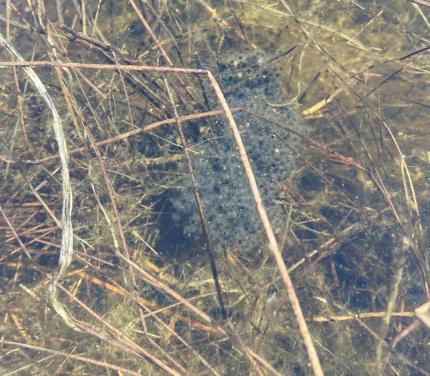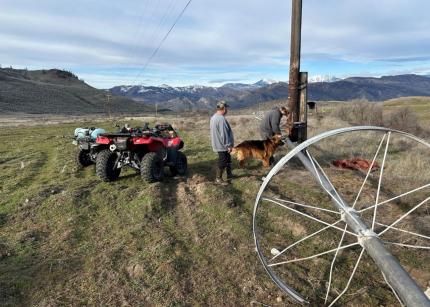Managing Wildlife Populations
Sinlahekin Beavers: Manager Wehmeyer was out inspecting campgrounds to see what spring maintenance needed to be done, when he came across an area that looked like someone had been falling trees. On further inspection the notorious sport faller was a beaver, that had been hard at work building its dam.


Sage Grouse Surveys: Biologist Morris continued sage grouse searches. He will be searching grids in Grant and Douglas counties without known sage grouse leks. He is hoping to find birds or new leks.
Ground Squirrels: Biologists Clements and Dougherty worked with Columbia Basin Wildlife Area staff members and borrowed equipment from the region Private Lands team to begin habitat enhancement work for Washington ground squirrels in the Seep Lakes Unit of the Columbia Basin Wildlife Area.
Northern Leopard Frogs: The District 5 frog team (Biologists Clements, Dougherty, Nason, Turnock, and Technicians Hara and Force) has been working to locate northern leopard frog egg masses to assist with species recovery efforts, to date there have been nine egg masses located. Eggs will be collected from each mass (which represents a single female breeding effort). The eggs will be transported to either a partner zoo or to the translocation site. The frog team will continue monitoring northern leopard frog breeding throughout the occupied areas. Additionally, the frog team will be adding two technicians in the coming weeks to further increase staff member capacity.



Waterfowl: In early March, Biologist Clements along with some additional Washington Department of Fish and Wildlife staff members participated in the U.S. Fish and Wildlife Service Pacific Flyway Wingbee Workshop in Redding, California. Hunters throughout the Pacific Flyway are selected and requested to submit the wings of their harvested geese and ducks throughout the season. Then biologists come together to determine species, sex and age of each wing. At this year’s workshop, biologists inspected 17,000 wings.


Greater Sage-grouse: Biologists across Douglas County continue to monitor known greater sage-grouse lek sites and search for new ones. A couple new leks have already been identified! Sage-grouse numbers recorded so far this spring are higher than they have been since the Pearl Hill fire, which is encouraging to see, because this species is classified as endangered by the State of Washington, and has been experiencing a dramatic population decline for many years now. For more information on greater sage-grouse in Washington, visit the WDFW website.



More recently, Biologist Clements assisted staff members from Alaska Department of Fish and Game with Canada goose captures. The capture efforts were primarily focused on lesser and Tavener’s Canada geese to better understand harvest and migration for these sub-species.


Wolf Cameras: Biologists Jeffreys, Eilers, and Morris picked up three remote trail cameras north of Lake Chelan that were used to survey the area for wolf occupancy. A female collared wolf from the Navarre pack was photographed. She was collared a couple years ago, but the collar malfunctioned and is no longer sending information. Other wildlife captured on camera included mule deer, bobcat, and coyote.
Spring Mule Deer Surveys: Biologists Fitkin and Heinlen started spring mule deer surveys to gather data on fawn recruitment. Early returns suggest over-winter fawn mortality was low, which is not surprising given the generally very mild winter conditions.




Mule Deer: Biologists Jeffreys and Eilers picked up 15 remote trail cameras on game trails near Blewett Pass. These cameras were used to capture images of the Wenatchee Mountains mule deer herd from October 2023 through December 2023 when they were undertaking their annual eastward migration to lower elevation winter range. Biologists will soon analyze all images collected to determine age and sex of photographed deer and use this information to generate fawn to doe and buck to doe ratios for the herd. Biologists will then compare these ratios with those obtained from aerial surveys that took place in December 2023 to determine whether remote camera placement could be a viable method to assess mule deer herd composition moving forward.


Providing Recreation Opportunities
Hunter Access: Biologist Morris checked and posted signs on hunter access properties.
Providing Conflict Prevention and Education
Livestock Depredation Claim Processing: Specialist Heilhecker provided information on a nonlethal deterrence checklist for a producer who filed a livestock depredation claim.
Wolf Non-Lethal Deterrence Outreach: Specialist Heilhecker worked with Communication Specialist Lehman and Wildlife Regional Program Manager Haug to update a nonlethal deterrence measure blog to be used on Washington State Department of Fish and Wildlife social media. The blog will go out this spring to remind producers of mitigation tools to minimize livestock-wolf interactions. The blog will also remind everyone that U.S. Fish and Wildlife Service manages wolves east of Highway 97.
Providing Information: Specialist Heilhecker provided comments to the Methow Valley Bear Assessment compiled by Home Range Wildlife Research. Home Range was contracted by Defenders of Wildlife to write the assessment. The assessment used Washington Department of Fish and Wildlife data to look for areas in Twisp, Winthrop, and Mazama that had repeated bear interactions due to unnatural attractants. Specialist Heilhecker provided clarifying comments to correct some information stated in the assessment.
Habitat Plots: Biologists Morris and Cook along with Technician Blanchard, planted several hundred trees and shrubs. These replants and additional plants were done in a previously planted plot that will provide cover and forage for upland game birds, deer, and non-game animals such as rodents, songbirds, and pollinators. Biologist Morris also sprayed weeds in the plot to reduce competition to the desirable native species and hopefully improve survival.
Supplemental Food Plots Preparation: Biologist Cook mowed three supplemental food plots, totaling 3.5 acres, to prep for herbicide application and seeding next month. Two of the three plots have permanent buried irrigation line and the third will be installed this spring. Puget Sound Chapter of Pheasants Forever is completing this installation as part of their habitat improvement efforts with this landowner. Irrigation is also done by a chapter member for the length of the season. Biologist Cook also helped transport the irrigation pipe for the new system to the site.
Conservation Reserve Program: Biologist Morris worked on more recommended leave areas for the Conservation Reserve Program to protect potential pygmy rabbit habitat. Part of the reason for preserving sagebrush areas is that it can take 10-20 years to get a stand of sagebrush that is mature and dense enough to support pygmy rabbits. Every time mature sagebrush is destroyed it resets the clock for another 10-20 years before the area could provide pygmy rabbit habitat again.


Conserving Natural Landscapes
Limebelt Forest Health: Scotch Creek staff members teamed up with the Sinlahekin staff members for a day of thinning on the Limebelt. In total, approximately ten acres were thinned.

Scotch Creek Riparian Restoration: Staff members constructed a new fence enclosure and added weave material to multiple beaver dam analogs within the project area. The enclosure will be planted with deciduous shrubs the first part of April.

Golden Doe Prescribed Burn: To aid in shrubsteppe restoration efforts, the Methow Wildlife Area conducted a prescribed fire operation in the Golden Doe Unit. Approximately 80 acres of predominantly invasive grasslands were burned, including several small aspen stands. By burning the non-native grasses and weeds, staff members can now treat the area more effectively with herbicide prior to planting native bunchgrasses this fall.
The aspen stands had been void of fire for many years, so it’s anticipated the area will experience strong regenerative growth after the fire. This will provide much needed forage and cover for a wide array of wildlife. Restoration efforts will continue in this area for years to come.
A special thanks to our Prescribed Fire Program for pulling this project together and providing staff members, equipment, and the necessary expertise to have a successful burn. Also, a big thanks goes out to all the wildlife area staff members who stepped up from around the region to help make this burn possible. Without the help of the other wildlife areas, this project would not have happened. The real rockstars of this project are Biologist Eidson (Columbia Basin Wildlife Area), Biologist Pavelchek (Wells Wildlife Area), Natural Resource Technician Zabreznik (Chelan Wildlife Area), Biologist Riley (Sinlahekin Wildlife Area), Natural Resource Technician White (Sinlahekin Wildlife Area), Natural Resource Technician Rise (Scotch Creek Wildlife Area), and Biologist Stanley (Scotch Creek Wildlife Area).
Additionally, we had a special guest assist on the burn, M. Danielson from Conservation Northwest. Danielson hopes to work with Washington Department of Fish and Wildlife to conduct some educational outreach with our partners about the benefits of prescribed burning. Last but not least, hats off to Methow Wildlife Area staff members, Biologist Repp and Natural Resource Specialist Wottlin for planning, prepping, and helping implement this important project.


Providing Education and Outreach
Private Lands Work Party: Biologists Morris, Cook, Braaten and Supervisor Rickel attended the Private Lands Work Party in Electric City. The private lands team from across the state met to work on some habitat projects, get training, get updates on the private lands program, and to network with other Private Lands staff members. There was a lot of rain and mud, but it was fun.



Sinlahekin and Scotch Creek Wildlife Area Advisory Committee: The Sinlahekin and Scotch Creek Wildlife Areas teamed up for their annual Wildlife Area Advisory Committee (WAAC) meeting. It was well attended, including several students from Oroville Schools who participated in the discussion. The Sinlahekin and Scotch Creek staff members provided updates on accomplished work and fielded a variety of questions. A good question and answer session occurred before wrapping up the meeting.
McFarland Middle School Career Day: Biologists Cook and Morris presented to five classes about working as a wildlife biologist at McFarland Middle School’s Career Day. Cook and Morris answered questions about work schedule, pay, and opportunities. They also answered some in depth questions like, what is the coolest animal that you have held or touched? Or what is the best part of your job? Most of the classes gained confidence and asked more questions early and others took a little longer. Cook and Morris told the students that at Washington Department of Fish and Wildlife there are many other staff members besides biologists and scientist, including officers, office staff, and more.
Conducting Business Operations and Policy
Charles and Mary Eder Agriculture Lease: Staff members helped disassemble the wheel lines and roll them to the edge of the field at the Charles and Mary Eder Agriculture Lease property so the field can be tilled and planted by the sharecropper.
Sinlahekin Residence Upgrades: The Sinlahekin residence received a much-needed roof replacement. The project was led by Capital Assets Management Program Construction Project Coordinator Noddings. Contractors removed the old asphalt shingle roof that was missing in some areas and replaced it with a new metal roof. The old roof outlived its life expectancy. The new roof should handle the elements a lot better than the asphalt shingles.


Other
Incidental Observations: The recent warm spells have coaxed snakes from their hibernacula. Rattlesnakes are now basking near their den entrances as conditions allow and other species like garter snakes and gopher snakes have begun foraging.



Scotch Creek Boundary Fence Repairs: Staff members repaired approximately two miles of boundary fence on the Scotch Creek Unit, one mile on the Ellemeham Unit, and one mile on the Tunk Unit.


Sinlahekin Fence Repair: Assistant Manager Riley and Natural Resource Specialist White have been using the nice weather to inspect and repair boundary fences on the Sinlahekin Wildlife Area. They have been repairing winter damaged fence and repairing areas that have been neglected for some time. They will be continuing this effort throughout the year.

Training: Staff members attended the Lands Division Quarterly and the Okanogan Noxious Weed Board winter recertification class for pesticide credits.